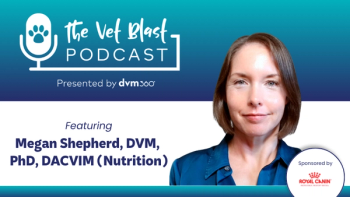
Enternal nutrition "on the cheap" (Proceedings)
Nutritional supplementation is vital to the healing process for most disease processes and after traumatic injury. However, many of these patients do not receive sufficient nutrition during the healing and recovery process. Over time, this lack of proteins, minerals, and energy substrates can lead to a state of general illness, malnutrition, and profound disability, a condition defined as cachexia.
Nutritional supplementation is vital to the healing process for most disease processes and after traumatic injury. However, many of these patients do not receive sufficient nutrition during the healing and recovery process. Over time, this lack of proteins, minerals, and energy substrates can lead to a state of general illness, malnutrition, and profound disability, a condition defined as cachexia. A cachexic patient has the potential to develop anemia, reduced cardiac mass and function, decreased pulmonary function and respiratory drive, and altered intestinal morphology and impaired absorptive ability. By providing nutrition to a patient unable to consume sufficient food, we can improve immune function, improve tissue synthesis and repair, improve intermediary drug metabolism, suppress the body's hypermetabolic response, reverse any carbohydrate imbalance, and reduce protein catabolism.
The first key in assessing whether a patient requires supplemental nutrition is to determine which patients are at risk for malnutrition. These patients may include patients in the ICU, patients with a recent weight loss >5% of body weight, patients with partial or complete anorexia of >3 days duration, patients with recent severe trauma or major surgery, patients with chronic vomiting or diarrhea, patients unable to intake food due to oro-facial trauma or neurologic deficit. For some patients, proactive nutritional intervention is beneficial. These are those patients we suspect will not eat for 3-5 days, as well as neonatal and juvenile puppies & kittens and obese cats.
Once those patients who may benefit from supplemental nutrition are identified, the next key to a nutritional program is determining what type of nutrition will suit them best. When all or part of the gastro-intestinal tract is available and functional, it is best to attempt to provide at least a portion of the patient's nutritional needs via the enteral route. This route has advantages since there are more options for nutritional supplementation and the cells lining the gastro-intestinal tract derive their nutrition via direct absorption from the intestine, rather than through the blood. If the gastro-intestinal tract is not functioning sufficiently, then the parenteral or intravenous route is preferred. Indications for parenteral nutrition include protracted vomiting, severe pancreatitis (controversial), and recent intestinal surgery. In some instances, there is some function to the gastro-intestinal tract but still a reason that not all nutritional requirements can be provided through enteral routes, so a combination of enteral and parenteral nutrition can be given.
Multiple forms of enteral nutrition are available. There is no need to be fancy since many basic forms of nutrition can be found at the local grocery store as well as from our pet food representatives. Enteral nutrition can, in its simplest form, consist of a carbohydrate source supplemented with electrolytes. More complex forms of enteral nutrition include liquid elemental diets, and critical care diets that can be mixed with water and blenderized.
These liquid enteral diets can be delivered in multiple different ways depending on the clinical condition of the patient. The easiest options for us for feeding our patients include offering food and coercion feeding. However, there are potential drawbacks to these methods including stress and insufficient or inconsistent caloric intake. Because of these, many times we do have to rely on assisted feeding through tubes. Options for feeding devices include naso-gastric or naso-esophageal feeding tubes, gastrostomy tubes, and enterostomy tubes. Placement of gastrostomy tubes can be performed either surgically, endoscopically assisted, or with the assistance of a specialized device called an "ELD". In neonates, gavage feeding can also be performed.
Providing nutrition does not end at determining which patients require nutrition, choosing the diets that we are to feed, and determining a method of delivering the nutrition. We must also determine how many calories and volumes of components to feed our patients. Many different calculations for determining caloric requirements are available. Most of these methods of calculating nutritional requirements are based on a patient's ideal body weight. Some of these methods also incorporate an "illness factor", although these are falling out of favor. The reason behind this is that studies are now showing that these "illness factors' tend to lead to over supplementation of nutrients and calories. A commonly accepted formula for determining caloric requirements in a patient receiving nutrition enterally is:
Resting Energy Requirement (RER)
70 (BW in kg) x 0.75 = kcal/day
Or
30 (BW in kg) + 70 = kcal/day for patients with BW between 2.0 - 45.0 kg
In some patients that are not able to tolerate full nutritional requirements by an enteral route, providing micro-enteral nutrition may still be of benefit. Micro-enteral nutrition is the delivery of small amounts of water, electrolytes, and readily absorbed nutrients directly to the gastro-intestinal tract to maintain mucosal cell integrity. Patients that are candidates for micro-enteral nutrition include those patients that are predisposed to or already have developed stress gastric ulceration and those patients that are early in recovery from severe GI disease, which may include patients with Parvovirus enteritis or have had a recent surgical intervention. Micro-enteral nutrition may assist these patients by allowing gastric decompression, improving regional GI blood flow, providing protection against GI bacterial and endotoxin absorption, and promoting progressive gastric motility.
Glutamine supplementation is a hot topic in veterinary nutrition. In human nutrition, glutamine is a conditionally essential amino acid that has multiple functions in the sick or injured. Glutamine has been shown to be necessary for the production of energy by the liver and kidneys, and is the preferred energy source in certain cells including renal tubular cells, enterocytes, immune cells, and endothelial cells. Glutamine is a "competence factor" necessary for intestinal cell proliferation, intestinal fluid and electrolyte absorption, and mitogenic response to growth factors. Glutamine deprivation produces apoptosis. It is available as a stable powder and is supplemented at a dose of at least 1 gram/kg body weight per day. Glutamine has been experimentally shown to decrease the time of post-operative gastro-intestinal ileus in dogs. Further studies regarding the necessity of this amino acid in critically ill undernourished patients are still pending for our veterinary patients.
Just because our patients start eating does not mean an abrupt end to supplemental enteral nutrition. Gradual discontinuation of assisted feeding should be performed when patient voluntarily consuming at least 1/2 of resting energy requirements. Unfortunately, there are no good tests to determine that assisted feeding is no longer needed. These clinical decisions should be based on when the patient has achieved good electrolyte balance and blood sugar control. Depending on the type of assisted feeding device placed, removal might not be warranted at the discontinuation of feeding by the tube. Removal of the tube is appropriate once assisted feeding is discontinued for a short period in patients receiving nutrition via a naso-gastric, naso-esophageal, or esophagostomy tube. However, patients receiving supplemental nutrition via a gastrostomy or enterostomy tube should only have their feeding tube removed after assisted feeding is discontinued for several days or after 7-10 days after tube placement, whichever is later. This will lessen the likelihood of leakage from the stoma in the stomach or intestine.
Parenteral nutrition, also known as intravenous nutrition, is a more complex undertaking. Formulations available for parenteral nutrition include pre-formulated amino acid solutions in a carbohydrate base, partial parenteral nutrition (PPN), and total parenteral nutrition (TPN). The simplest form is a pre-formulated amino acid solution in a carbohydrate base, such as Procalamine™. The carbohydrate source is glycerol, which enters cells in insulin-independent process and behaves similarly to glucose intra-cellularly. These formulations often contain electrolytes, so this should also be accounted for. To make these a more complete source of nutrition, these diets can be combined with lipids to provide a fat source. Amino acid in glycerol solutions can be administered via a peripheral vein at a maintenance fluid rate (60ml/kg/day). This rate will provide approximately 25% of a patient's basal caloric needs.
Partial parenteral nutrition is a specialized fluid made of amino acids, lipids, and electrolyte solution with 5% dextrose as the carbohydrate source. Vitamins and trace minerals can be added to make these solutions more complete. Because this solution is only mildly hyperosmolar, it can be delivered through peripheral or central vein. Partial parenteral nutrition provides up to 50-70% of basal metabolic requirements. Because there are no preservatives and the glucose and lipids are excellent sources for bacterial growth, aseptic technique must be used to prepare each solution. Each bag of these solutions should only be used for a maximum of 24 hours and then discarded. Potential complications of PPN include thrombophlebitis, loss of glucose regulation, electrolyte abnormalities, and fluid overload.
Total parenteral nutrition (TPN) is also a specialized fluid made of amino acids, lipids, and electrolytes. The difference is that the carbohydrate source is a 50% glucose solution. Because of this increased carbohydrate load, 100% of a patient's basal metabolic needs can be met. Due to the increased osmolarity of the 50% dextrose solution, it must be delivered through a central vein. Also, because of this, monitoring must be more diligent and the potential for complications is increased.
Nutritional supplementation is an easy way to help support our patients through protracted illness or injury. By following several simple steps, we can help our patients to a more rapid and complete medical recovery.
References furnished upon request
Newsletter
From exam room tips to practice management insights, get trusted veterinary news delivered straight to your inbox—subscribe to dvm360.




